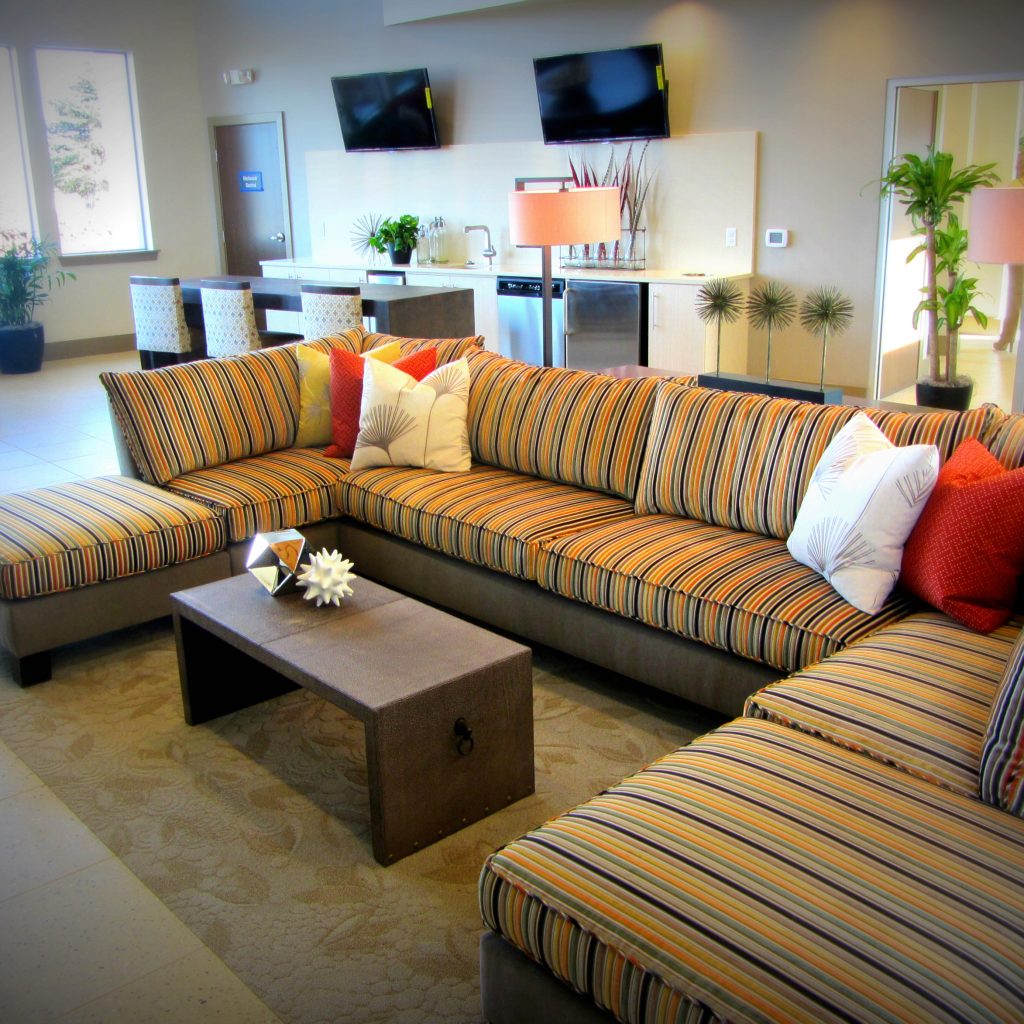“How many yards of fabric does this chair require?”
“What about railroaded versus up-the-roll application?”
“What if my client would like leather instead?”
“What if I want to specify a 52” wide fabric with a 10”vertical repeat and a 5” horizontal repeat?”
Don’t worry, we’ve got you covered! On our website and on other furniture websites, you’ll often see yardage requirements listed for COM (customer’s own material) and COL (customer’s own leather). All of our pricing is COM, which means that you’ll be ordering your upholstery fabric from the textile company of your choice and having it shipped to our factory.
Unfortunately, not all fabrics are created equal. Standard plain goods like solids and vinyls are generally sold by the yard in 54” wide pieces and can be applied railroaded. The COM requirements noted on our website apply to 54” plain, non-directional, railroaded goods. If the fabric you have specified falls in this category, you can certainly move forward with the requirements as noted on our website during your planning and budgeting phase. But what if you are specifying fabric that isn’t 54” plain, railroaded goods?
To calculate how much yardage of a striped or patterned fabric you’ll need to order, the first step is to determine the repeat of the pattern. You can easily locate this information on the memo sample or online description of your fabric. You will encounter fabrics that only have a horizontal repeat, fabrics that only have a vertical repeat, and fabrics that have both a horizontal and vertical repeat. In the case of the latter, you’ll need to add the vertical and horizontal repeats together to determine the total repeat.
Second, you’ll need to determine how wide the fabric is. As stated above, most plain fabric is 54” wide, but this can vary. The width of the fabric can be found on the memo sample or online description of the fabric, usually near the repeat information.
Now you are ready to calculate the necessary yardage! Using the chart below, look up your fabric width and the total fabric repeat to determine the percentage of additional yardage your furniture will require.
For example, our Eileen Chair requires 6 yds of standard COM (54” plain, railroaded goods). If the fabric you are specifying is 52” wide and has 10” vertical repeat and a 5” horizontal repeat (15” total repeat), the chair would require 25% more yardage than standard, or 7.5 yards total. In your calculations, simply round up to the nearest half yard.
What about directional fabric?
Velvets and certain types of textured fabric have a nap which make them “directional” fabrics. Even though they may be plain, these fabrics must be applied up-the-roll rather than railroaded, which will require 10% more yardage than our standard COM requirement.
What does it mean to “railroad” or apply fabrics “up the roll”?
The suggested application methods for a fabric can be either “railroaded” or “up-the-roll” (also sometimes referred to as “off the roll,” “regular” or “non-railroaded” just to make keep things interesting). Railroading the fabric enables an upholsterer to cover the most upholstery with the least amount of fabric. This method is used for plain, non-directional fabrics. (If you are watching your budget, keep this in mind, as additional yardage can add up fast!) Railroading a fabric also means an upholsterer can cover a large piece of furniture, such a tight-back sectional, without any vertical seams. Up-the-roll application is generally used for patterns that need to be matched, stripes, and other directional fabrics. This type of fabric will require seams on larger pieces of furniture. See the diagram below for an illustration. The first image demonstrates a railroaded application, while the second demonstrates an up-the-roll application.
What about leather?
To convert a COM requirement to a COL requirement, simply multiply the yardage required by 18. If a chair requires 6 yards of COM, it will require 108 square feet of leather. (Leather is a natural product with irregularities; this conversion method takes that into account.) You will need to inquire with your leather vendor to determine the average hide size (often between 40-55 square feet) so that you can determine how many hides you will need to order. One special note, because our standard pricing is COM, there is an up-charge to upholster our furniture in leather. For small orders, this up-charge is 15%-20% of the net price. Please contact us to verify COL pricing.
You are now an expert!
But don’t worry, if you feel a little confused you are not alone. Feel free to contact us with your furniture and fabric specifications we’d be happy to calculate the yardage required. (Just don’t forget to include the fabric manufacturer/ pattern name/ color of your fabric and if possible, the repeat and width information.)


